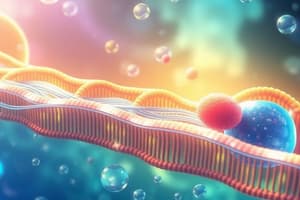Podcast
Questions and Answers
What is required for active transport to occur?
What is required for active transport to occur?
- Presence of water
- Energy from ATP (correct)
- High ionic concentration
- Active movement of molecules
Passive transport requires energy to move substances across the cell membrane.
Passive transport requires energy to move substances across the cell membrane.
False (B)
Name one example of active transport.
Name one example of active transport.
Sodium-potassium pump
Active transport moves substances from an area of ______ concentration to an area of ______ concentration.
Active transport moves substances from an area of ______ concentration to an area of ______ concentration.
Match the following transport processes with their characteristics:
Match the following transport processes with their characteristics:
What is the primary role of ATP in active transport?
What is the primary role of ATP in active transport?
The sodium-potassium pump transports potassium ions out of the cell and sodium ions into the cell.
The sodium-potassium pump transports potassium ions out of the cell and sodium ions into the cell.
What mechanism allows glucose to be absorbed into intestinal cells despite a higher concentration inside them?
What mechanism allows glucose to be absorbed into intestinal cells despite a higher concentration inside them?
Active transport allows plant roots to absorb essential minerals from the soil, even when these minerals are in _____ concentration in the soil than inside the root cells.
Active transport allows plant roots to absorb essential minerals from the soil, even when these minerals are in _____ concentration in the soil than inside the root cells.
Match the following processes with their respective roles:
Match the following processes with their respective roles:
Flashcards are hidden until you start studying
Study Notes
Introduction to Active Transport
- Active transport is the movement of substances across cell membranes against a concentration gradient, requiring energy input.
- Unlike passive transport, which moves substances from high to low concentration, active transport moves them from low to high concentration.
- The energy for active transport is typically derived from ATP (adenosine triphosphate), the cell's primary energy currency.
- Carrier proteins within the cell membrane are utilized to transport molecules during active transport.
Difference Between Passive and Active Transport
-
Passive Transport:
- Movement occurs from higher to lower concentration without energy use.
- Diffusion: Involves the movement of particles following the concentration gradient.
- Osmosis: A specific diffusion of water across a semipermeable membrane, from low to high solute concentration.
- Facilitated Diffusion: Uses carrier proteins to assist molecules across membranes without energy expenditure, still moving down the concentration gradient.
-
Active Transport:
- Requires energy to move substances against their concentration gradient.
- Relies on specific pumps or carrier proteins to transport substances.
- Examples include the sodium-potassium pump, glucose absorption in intestines, and mineral uptake by plant roots.
Key Processes and Examples
-
Sodium-Potassium Pump:
- An essential active transport mechanism in animal cells maintaining electrochemical gradients.
- Process involves binding three sodium ions (Na⁺), hydrolyzing ATP to energize transport, and exchanging for two potassium ions (K⁺).
- Results in higher intracellular potassium and extracellular sodium concentrations, crucial for nerve and muscle functions.
-
Glucose Uptake in the Small Intestine:
- Glucose is absorbed into intestinal cells through active transport, even against its concentration gradient.
- Utilizes a sodium-glucose co-transporter, relying on the sodium-potassium pump to maintain sodium gradients for effective glucose transport.
The Role of ATP in Active Transport
- ATP hydrolysis provides energy by breaking the bond between its second and third phosphate groups to form ADP and inorganic phosphate.
- This energy facilitates conformational changes in carrier proteins, allowing substance transport against concentration gradients.
Significance of Active Transport in Organisms
-
Plant Roots:
- Essential for the uptake of minerals like potassium, nitrate, and phosphate from soil, enabling nutrient acquisition necessary for growth.
-
Kidneys:
- Active transport is critical in the kidneys for reabsorbing glucose, amino acids, and other vital molecules from filtrate back to the bloodstream, maintaining homeostasis.
Factors Affecting Active Transport
- Temperature:
- Higher temperatures increase kinetic energy, enhancing the activity of enzymes involved in ATP production, thus improving the rate of active transport.
- Extremely high temperatures can denature proteins, potentially impairing active transport functions.
Studying That Suits You
Use AI to generate personalized quizzes and flashcards to suit your learning preferences.



